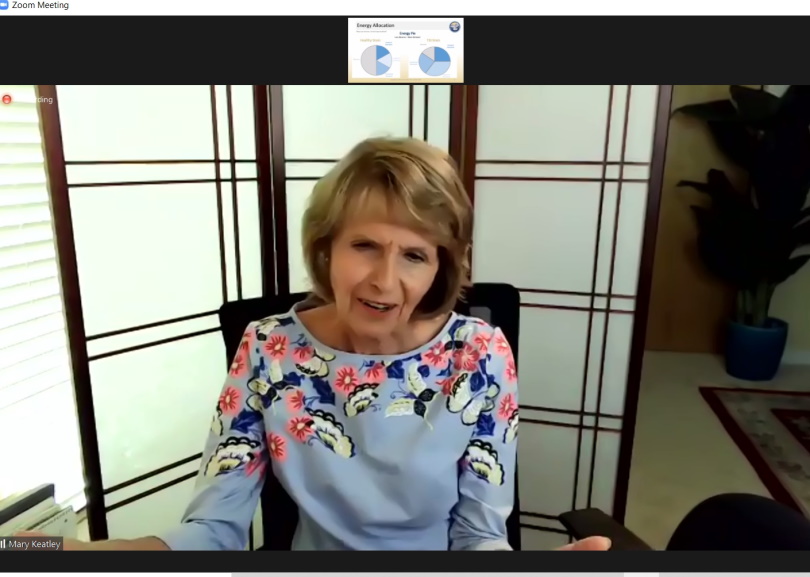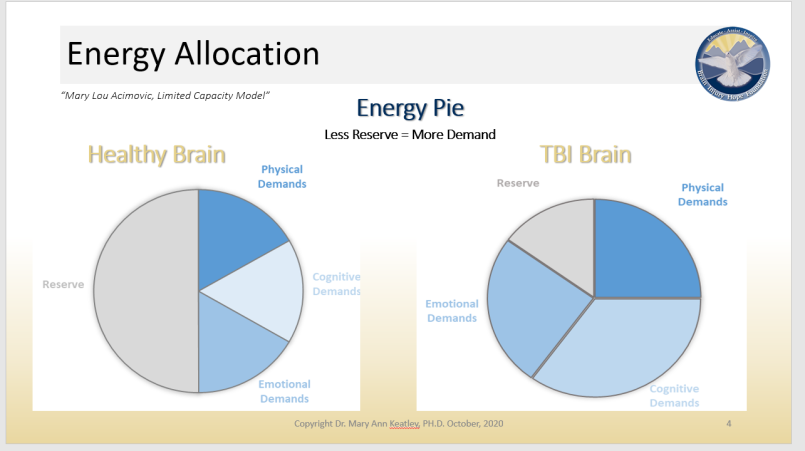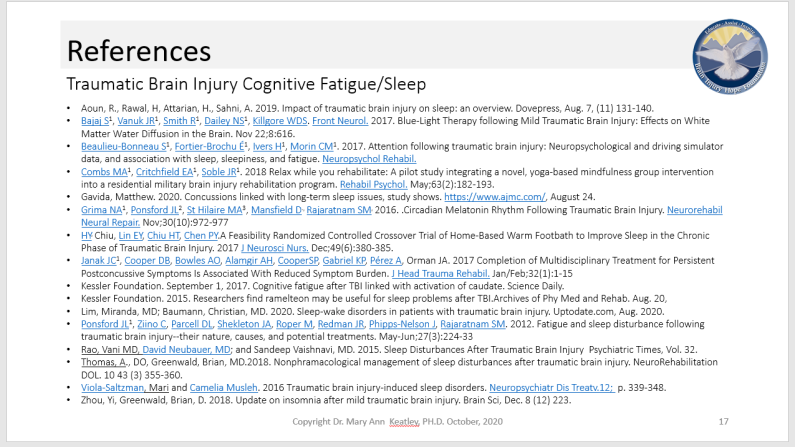
Co-founder of The Brain Injury Hope Foundation Mary Ann Keatley explains the Energy Pie during the October 2020 Survivor Series via Zoom.
By Eliza Marie Somers
We’ve all experienced exhaustion: When we are so tried after a long day we just collapse on the sofa, lacking the energy to take a shower or even to eat. Now multiply that by 10, and that’s what a majority of brain injury survivors go through day in and day out.
However, there is hope for mTBI survivors said Brain Injury Hope Foundation co-founder Dr. Mary Ann Keatley during the October 2020 Survivor Series: Cognitive Rehabilitation and Mental Fatigue. Keatley outlined numerous strategies we can immediately take to battle fatigue.
“It takes more energy to do everyday life tasks after a brain injury – like getting dressed, brushing your teeth, and eating breakfast because it takes energy to process the food,” Keatley said. “The mental fatigue is real, even years post injury.
“People can’t return to work or socialize, or have the ability to pay bills. Your quality of life becomes affected,” she explained.
One of the first things Keatley recommended is to have your doctor take a look at thyroid functions.
“I’ve looked at the literature very carefully, and there are a lot of molecular changes that take place after a brain injury; 25 to 50 percent of TBI survivors have thyroid problems after an injury,” she explained.
Another important factor in addressing fatigue is to determine what TYPE of exhaustion you are experiencing:
- Physical – Occurs when you do physical tasks, such as house cleaning, gardening, working out.
- Cognitive – Occurs when you think, concentrate, read or solve problems, such as balancing a checkbook, making a new recipe or helping your child with homework.
- Emotional – Occurs when you are stressed or experience depression, such as having a fight with your spouse. This type of fatigue often occurs when you awaken in the morning.
“Your brain is like a camera shutter,” Keatley said. “It opens and closes, but after focusing intently for a while your brain shuts down.”
Thus, you shut down. That is why it’s important to figure out what you can do to avoid a total crash.
- Keatley noted a recent study by The Kessler Foundation in which it found that cognitive fatigue in TBI survivors is linked to changes in the caudate nucleus and basal ganglia portions of the brain. Researchers believe this may lead to interventions to ease fatigue due to brain injuries and other neurological disorders. Here is a link to the study.
Another way to look at the fatigue survivors of brain injuries experience is to look at the Energy Pie. A person with a healthy brain has plenty of energy reserves left over after a full day, but a person with a brain injury has just a small slice of reserves left because it takes more energy to do “normal life tasks.”

“It’s very emotional; you are not who you were before the injury, and that also takes a lot of energy to understand,” Keatley said. “You have to change your life for a to period of time manage your life. So, what can you do? The first thing to do is to start with pacing.
Pomodoro Timing
Pace yourself by doing a little bit, then resting, then doing a little more, then resting again.
“There’s a technique called the Pomodoro – Italian for tomato,” Keatley explained. “A gentleman used a timer on the stove that looked like a tomato. He would set it for 25 minutes and do a task, then rest for five minutes. The he would set it again, and rest for 10 minutes. … It’s been proven that we are better able to do more by this method than powering through.”
Another method is to assess energy by giving a task a percentage of your total energy for the day. For example: grocery shopping takes a lot of energy because of the fluorescent lights, the sounds and the overwhelming choices. So grocery shopping might be all that you do that day. Plus you can minimize the energy task by taking precautions, such as wearing ear filters, dark glasses and a wide brim hat.
Eisenhower Method
Organizing daily tasks can become so overwhelming for a TBI survivor that nothing gets done. You know that pile of mail that keeps growing, or those files that need to be sorted or those emails that have to be read and answered. The piles keep getting bigger and bigger, and the tasks now seem insurmountable.
Keatley suggests using the Eisenhower Method, which is named after Dwight D. Eisenhower, the 34th president of the United States. To tackle his daily tasks, Eisenhower would categorize them into four priorities.
- Priority 1 – Urgent and important: Do task immediately.
- Priority 2 – Important but not urgent: Schedule task to do later.
- Priority 3 – Urgent but not important: Put on your list or delegate.
- Priority 4 – Not urgent or important: Eliminate or do later.
“After a brain injury all tasks seem to hold the same weight,” Keatley explained, “but by putting them in categories you don’t become so overwhelmed.”
Sleep Issues
Trouble sleeping is a prevalent and persistent problem among survivors of brain injuries, and sleep-wake disturbances are often is undiagnosed and under-reported.
“Cognitive fatigue can make you feel confused,” Keatley said. “With a TBI, your brain goes into a theta brain wave state to heal itself, and it can make you feel foggy. It’s part of the recovery process.”
Biochemical changes in the brain are one cause of sleep problems, as Keatley noted TBI survivors tend to produce 42 percent LESS melatonin than the normal population.
“I would hear from so many patients that they would wake up at 3 a.m. and never go back to sleep,” Keatley said.
Other causes of sleep disturbances are pain, sleep fragmentation or less REM sleep, sleep apnea and limb movement (restless leg syndrome).
Some ways to tackle sleep issues are:
- Sleep Hygiene and Behavioral Therapy
- Light Therapy
- Chiropractic and Osteopathic Manipulative Treatment
- Acupuncture
- Diet
- Herbs and Supplements
- Warm Foot Baths
- Medications
For more information on treatments:
Sleep Hygiene and Light Therapy
Chiropractic and Acupuncture
Diet, Herbs, Medications
wo books to consult on blue light therapy “The Circadian Code” and “Regenerate”
Wearing blue blocking glasses at night and using the blue light filters on your phone and computer can help with sleep disturbances. Sitting in front of a blue light lamp, such as the TaoTronics Light Therapy Lamp, in the morning can also help reset the circadian patterns.
“Blue light therapy reduced fatigue significantly in people with TBIs,” Keatley said. “It was more effective doing it in the morning by giving people more energy and less cognitive fatigue.”
Warm foot baths for 30 minutes one to two hours before bedtime decreased the waking time of TBI survivors, Keatley said. And setting the bedroom temperature a little cooler than the rest of the house and limiting alcohol consumption are some other suggestions to help you get a good night’s rest.
At the end of the day, fatigue management is one of the best ways to battle exhaustion after a TBI.
“Pace yourself,” Keatley said. “When you have cognitive fatigue, stop what you are doing. Don’t push yourself. And ask for help. For some people it’s kind of a gift for them.”
References


